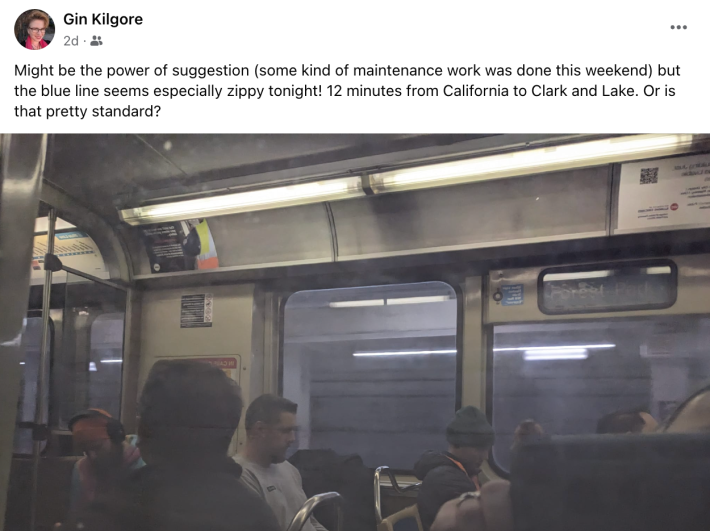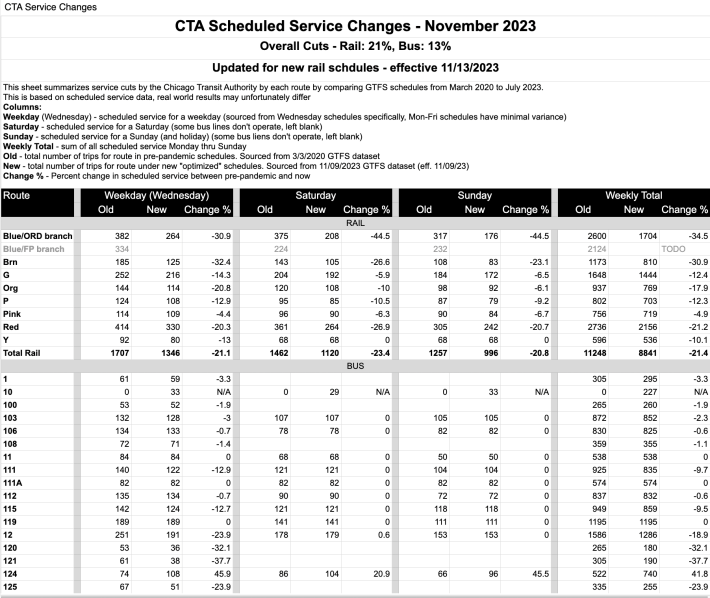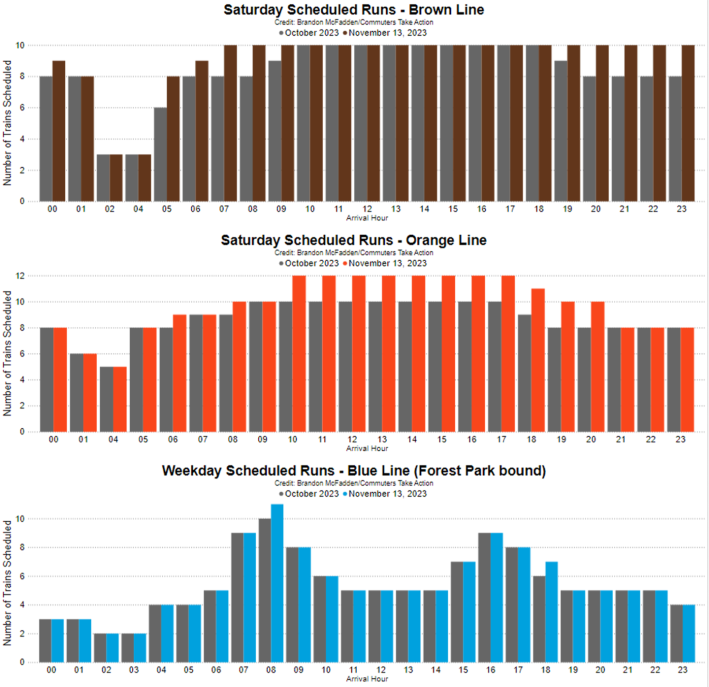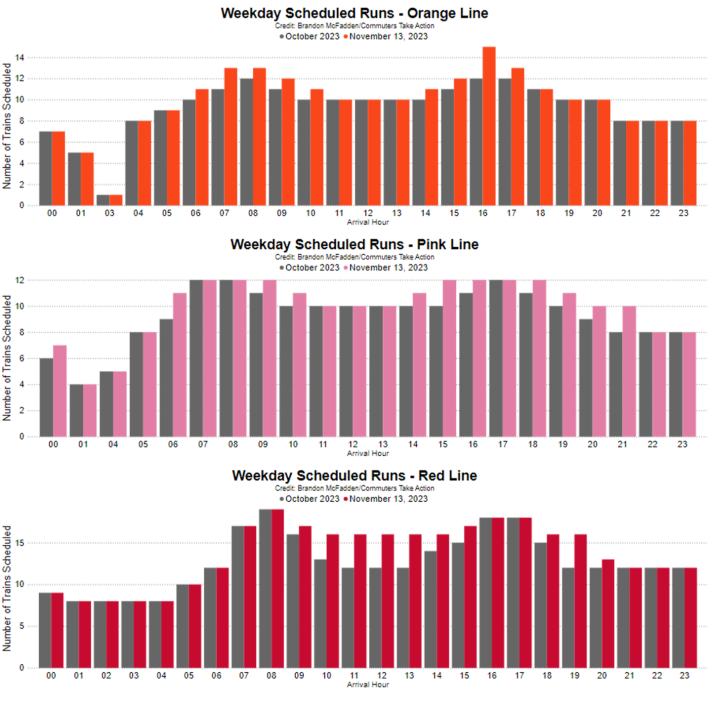
Update 11/10/23, 10:00 AM: While the Active Transportation Alliance's statement provide to Streetsblog in response to the CTA announcement was fairly complimentary, the advocacy group's planning director David Powe, a former transit planner, had some harsh words for the transit agency Thursday afternoon on Twitter.
More smoke & mirrors from @cta. No plan to hire, train & retain more rail operators. No commitments to more rail operator trainings. No schedules to share. https://t.co/0rQBtMhQ8s https://t.co/6CPtOVXV7s
— David Powe (@frasiertrain) November 9, 2023
There was some good news for the CTA in on October 8 when the Forest Park Branch tracks fully reopened as planned, just in time for the Chicago Marathon. That meant the Blue Line was making all stops from the Forest Park station to the O'Hare Airport stop for the first time since late July.
On the other hand, that same day the transit agency kicked off a new rail schedule that involved service reductions. That was evident from the General Transit Feed Specification published by the CTA earlier that week, but not publicized by the agency.
A few hours after Streetsblog published a guest op-ed by Commuters Take Action's Brandon McFadden about the service cuts, the transit agency acknowledged the bad news in a statement. But it added that "we will add back rail service to [spring 2023] scheduled service" in mid-November. That would be after a train-turnaround area just west of the Blue Line UIC-Halsted (800 W.) station, called the "Morgan Middle" is rebuilt.
This turnaround is used to “short-turn” runs so more service can be focused in high-ridership areas. The agency said that when this happened, it would benefit multiple rail routes.
According to a press release the CTA released today, the service improvements are starting this weekend. It promised that riders would experience shorter waits between trains and more reliable service since the new "scheduled service reflects the available workforce."
"Effective Monday, November 13, more frequent rail service will be scheduled on weekday Red, Orange and Pink Lines," the CTA stated. "Effective, November 18, Saturday scheduled service on both the Brown and Orange lines will be increasing." The release promised that additional 'L' service would be added next year because of "aggressive efforts to hire and trains more rail operators."
Here the new scheduled service (CTA language):
Weekday
- Red Line: Midday and evening headways drop from 10 to 7.5 minutes.
- Orange Line: AM and PM peak headways drop from 10 to 8.5 minutes.
- Pink Line: Early AM and early evening headways drop from 12 to 10 minutes.
Saturday
- Brown Line:
- AM and evening and late evening headways drop from 15 to 12 minutes.
- Early AM peak headways drop from 20 to 15 minutes.
- Orange Line:
- Early AM and evening peak headways drop from 15 to 12 minutes.
- Midday peak headways drop from 12 to 10 minutes.

The new CTA release said that another perk of Morgan Middle being available again is trains can be turned on track that isn't being used for 'L' service, which otherwise could delay other trains carrying passengers. In addition, the agency stated, turning trains back at UIC-Halsted, the highest-ridership Forest Park Branch station, instead of LaSalle station (130 W.) (as was the case for the last few months), will benefit UIC-Halsted customers.
As for the Blue Line, the CTA stated that now that the Morgan Middle turnaround can be used, "O’Hare-bound train headways at UIC-Halsted will be scheduled every 6 -12 minutes instead of 10 -12 minutes weekdays between 6:30 a.m. and 9 a.m., and 6 - 7.5 minutes instead 10 minutes between 3:30 p.m. and 6 p.m."
"We commend CTA for working to restore rail service and increase frequency on several rail lines during typical weekday peak hours," Active Transportation Alliance advocacy manager Julia Gerasimenko told Streetsblog. "We will continue to advocate for further increasing frequency on all of the rail lines seven days a week and during non peak hours. It's essential that the agency continues to focus on recruiting, training, and retaining railway workers as they work to further restore pre-pandemic levels of service."
Commuters Take Action (CTAction) also initially applauded the news. "We are excited to see improvements to scheduled rail service on the L," the group said in a statement. "Any increase in frequency is welcome."
But Commuters Take Action said they weren't confident CTA will be able to come through with the more frequent service it's predicting. "In the past few weeks, there have been several days where a few lines ran 100 percent of their scheduled service but there have not been any days where alI of the lines ran at least 90 percent of scheduled service. We feel that it’s important that CTA can actually consistently deliver 100 percent on the current schedule before they start increasing service. Otherwise, overambitious goals could stretch the current workforce too thin and cause burnout."
On the other hand, Commuters Take Action noted that while service is returning to pre-Blue Line reconstruction levels, that's still much lower than pre-COVID-19 frequency. "Blue line frequencies of 6 minutes are insufficient during rush hour, especially when the CTA fails to deliver on these consistently, which is an everyday sight. We predict that riders will continue to face intermittent 15-plus-minute headways during the busiest times on all lines. This can only be fixed by comprehensive operational procedures overhaul and running a workforce that isn’t spread too thin."
This afternoon the CTA put out a new General Transit Feed Specification with the updated schedule. Commuters Take Action updated their interactive map of CTA Service Changes, and their table of the changes, below. Graphics of the November changes by Brandon McFadden are posted at the bottom of this piece.

"We are disappointed by the CTA’s lies about Blue Line service," Commuters Take Action said after the new schedule became available. "Earlier, the agency stated that Blue Line service would go back to pre-Forest Park Rebuild service levels in mid-November. However, the Bue line has 13 percent less scheduled service now than it did in July 2023, and 35 percent less than 2019."
CTAction argued that the O'Hare Branch still has less-than-adequate service under the new schedule, particularly during rush hours. "Other lines saw some modest improvements, but all service is still considerably below 2019 levels with a 21 percent reduction overall.
Here’s Commuters Take Action's summary of changes by line:
- Blue
- Weekday - 1 additional train per hour in AM and PM rush
- Saturday/Sunday - no change
- Brown
- Weekday - no change
- Saturday/Sunday - 10 trains per hour between 7am and 11pm, up from 8
- Green - no change
- Orange
- Weekday - 3 additional trains per hour during peak hours
- Saturday - 2 additional trains per hour between 10am and 8pm
- Sunday - no change
- Pink
- Weekday - 8 additional trains in late afternoon/evening
- Saturday/Sunday - no change
- Purple - no change
- Red
- Weekday - additional 2 trains per hour during mid-day
- Saturday/Sunday - no change
- Yellow - no change
And here are their graphics of the November changes.


Weekday scheduled runs for the Orange, Pink, and Red lines in October 2023 (gray) and on November 13, 2023 (color). Image: Brandon McFadden, Commuters Take Action

Did you appreciate this post? Please consider making a tax-deductible donation.




